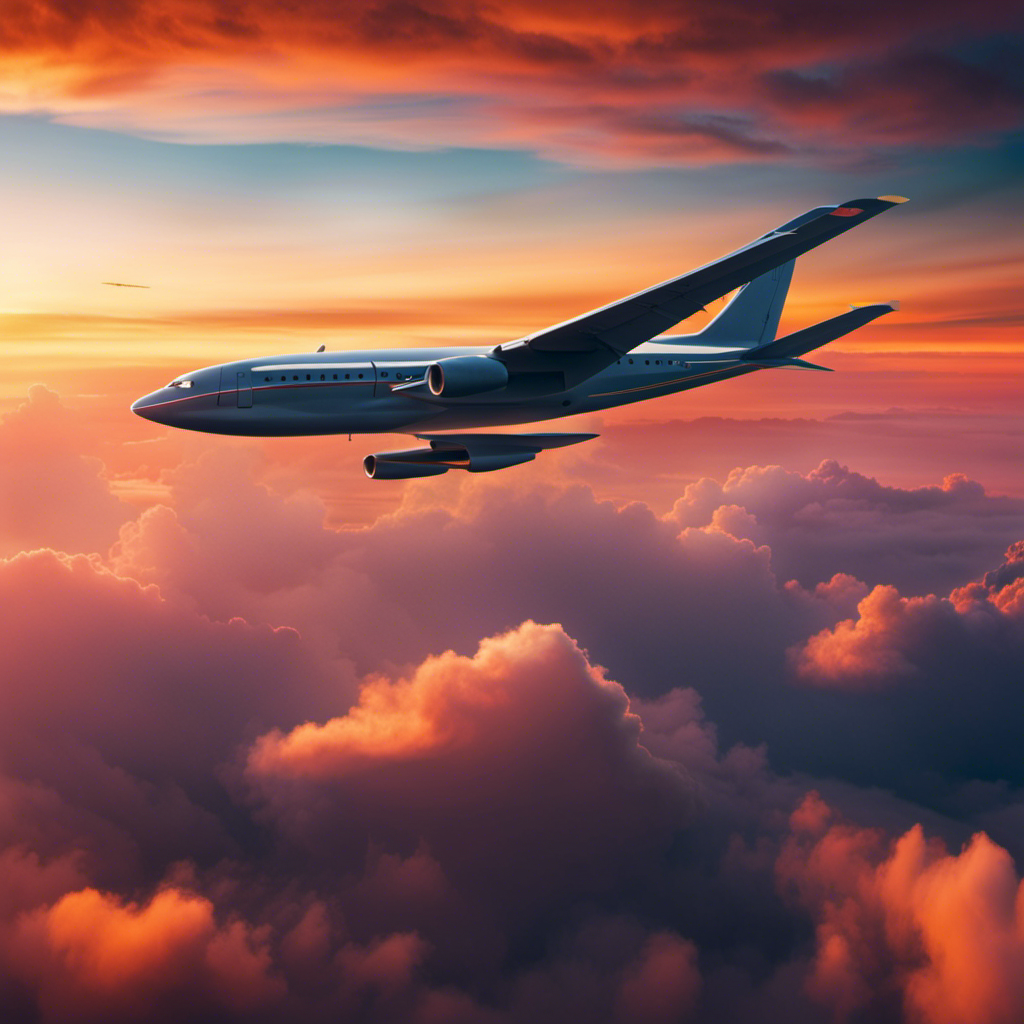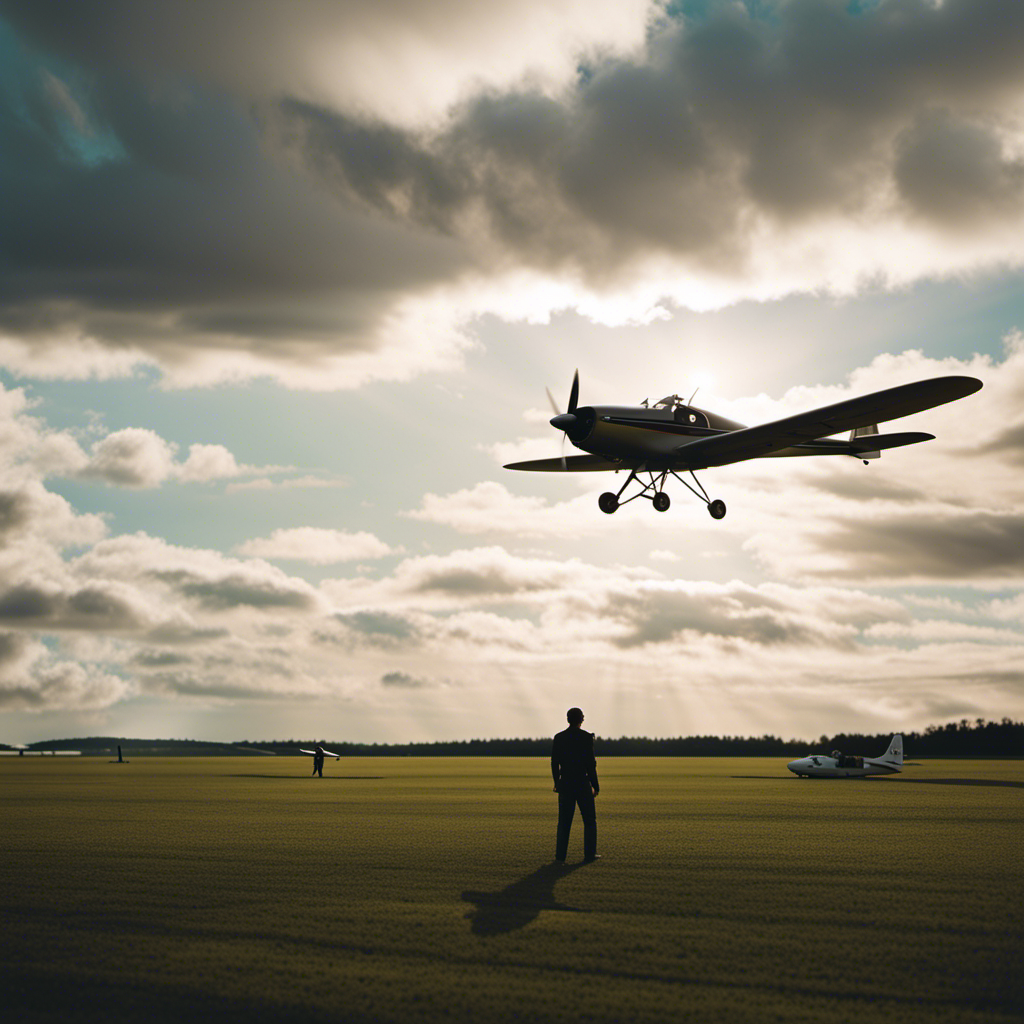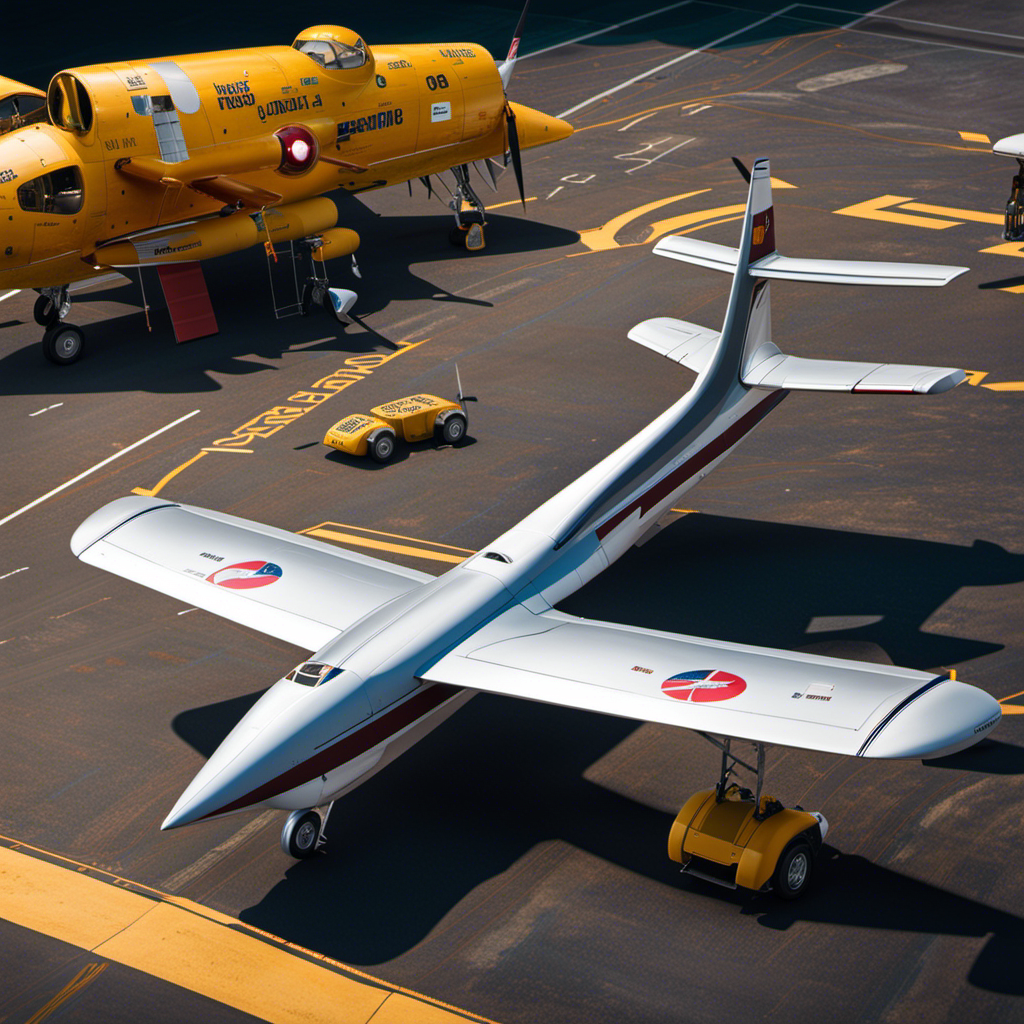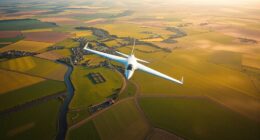As a passionate aviation enthusiast, I am constantly in awe of the impressive capability of airplanes to soar through the skies.
The question of how long an airplane can glide is a complex one, involving the mechanics of flight, external factors, and pilot training.
In this article, we will delve into the intricacies of airplane gliding, exploring the factors that affect gliding distance, notable instances of successful emergency glides, and the importance of gliding in aviation safety.
Join me on this technical journey as we uncover the secrets and debunk common myths about airplane gliding.
Key Takeaways
- Gliding is a crucial skill for pilots in emergencies, allowing them to maneuver aircraft effectively and safely.
- The duration of a gliding flight depends on altitude, airspeed, and aircraft design, with the depletion of potential energy leading to a gradual loss of altitude.
- Gliding techniques and characteristics vary depending on the weight, wing design, and aerodynamics of the aircraft.
- Future developments in gliding technology aim to improve aircraft efficiency and performance, extending range, enhancing safety, and improving efficiency.
The Mechanics of Airplane Gliding
You’ll be surprised how far an airplane can glide without power. The mechanics of airplane gliding are fascinating, governed by the principles of fuselage aerodynamics, lift, and drag forces.
When an airplane is in glide mode, the fuselage shape plays a crucial role in its performance. The streamlined design reduces drag, allowing the aircraft to maintain its forward momentum. Lift forces, generated by the wings, counteract the weight of the airplane and keep it afloat. The drag forces, on the other hand, act in the opposite direction, resisting the forward motion.
Factors Affecting an Airplane’s Gliding Distance
When discussing the factors affecting an airplane’s gliding distance, three key points come to mind: altitude and airspeed, weight and wing design, and environmental conditions.
Altitude and airspeed play a crucial role in determining how far an airplane can glide, as higher altitudes provide more potential energy and higher airspeeds can help maintain lift.
Additionally, the weight of the aircraft and the design of its wings are important factors to consider, as heavier planes may experience more drag and wings with a higher aspect ratio can provide better glide performance.
Lastly, environmental conditions such as wind speed and direction can greatly impact the gliding distance of an airplane, as they can either enhance or hinder its ability to maintain lift and control.
Altitude and Airspeed
The airplane can maintain altitude and airspeed by adjusting the control surfaces. These two factors play a crucial role in determining the gliding distance of an aircraft. Here are some key points to consider:
-
Altitude: The higher the altitude, the greater potential energy the airplane possesses. This allows for a longer gliding distance as the aircraft can convert this energy into forward motion.
-
Airspeed: The airspeed affects the lift generated by the wings. Higher airspeed results in greater lift, which can help the airplane maintain altitude and extend the gliding distance.
-
Angle of attack: The angle at which the airplane meets the oncoming air affects its ability to generate lift. Adjusting the angle of attack can optimize lift and maximize gliding distance.
-
Control inputs: Proper and precise control inputs allow the pilot to maintain the desired altitude and airspeed during the glide, ensuring optimal gliding distance.
-
Aircraft configuration: The configuration of the airplane, such as the deployment of flaps or landing gear, can impact both the altitude and airspeed, thus influencing the gliding distance.
Considering the importance of altitude and airspeed in determining gliding distance, it is crucial to understand the impact of weight and wing design on these factors.
Weight and Wing Design
To optimize your gliding distance, consider how weight and wing design affect altitude and airspeed. Weight distribution plays a crucial role in an airplane’s ability to glide. By properly distributing the weight, the airplane achieves a more balanced and stable flight, enabling it to maintain altitude for a longer period. Additionally, the shape of the wings greatly impacts the gliding capabilities. Wing shape affects lift and drag, which directly influence the airplane’s ability to stay airborne. A streamlined wing shape reduces drag, allowing the airplane to maintain a higher airspeed and cover more distance while gliding. Consider the following table that highlights the relationship between weight distribution and wing shape in gliding performance:
| Weight Distribution | Wing Shape |
|---|---|
| Balanced | Streamlined |
| Forward | Swept-back |
| Aft | Straight |
Understanding the importance of weight distribution and wing shape in gliding can help pilots make informed decisions to maximize their aircraft’s gliding potential. Now, let’s explore how environmental conditions impact gliding performance.
Environmental Conditions
Consider how environmental conditions can impact your gliding performance. Factors such as wind speed and direction, as well as air temperature, play a crucial role in determining the aircraft’s ability to glide efficiently.
Wind speed and direction affect the aircraft’s groundspeed and therefore its glide ratio. A headwind can increase the aircraft’s glide distance, while a tailwind can reduce it.
Similarly, air temperature influences the aircraft’s lift and drag characteristics, affecting its glide performance. Warmer air tends to decrease lift, resulting in a shorter glide, while cooler air can increase lift and extend the glide.
Therefore, understanding and accounting for these environmental factors is essential for optimizing aircraft performance during a gliding situation.
Now, let’s delve into notable instances of successful emergency glides.
Notable Instances of Successful Emergency Glides
You might be interested to know about some notable instances where pilots successfully glided airplanes in emergency situations. These successful emergency landings are a testament to the remarkable skills and decision-making abilities of pilots.
One such instance occurred in 2009, when Captain Chesley Sullenberger successfully landed US Airways Flight 1549 on the Hudson River after both engines were disabled by a bird strike.
Another example is the Gimli Glider incident in 1983, where Captain Robert Pearson safely landed an Air Canada Boeing 767 after it ran out of fuel due to a miscalculation.
These instances highlight the importance of pilot training and the ability to make critical decisions under pressure.
Transitioning into the subsequent section about pilot training and emergency procedures, it is crucial for pilots to receive comprehensive training to handle emergency situations effectively.
Pilot Training and Emergency Procedures
Pilots undergo extensive training to learn how to handle emergency situations effectively. This training is crucial for ensuring pilot performance and the safe operation of an aircraft. Here are three key aspects of pilot training and emergency procedures:
-
Simulated emergencies: Pilots are exposed to various simulated emergency scenarios during their training. This helps them develop the necessary skills to respond quickly and accurately in high-stress situations.
-
Emergency checklists: Pilots are trained to follow specific checklists when faced with an emergency. These checklists provide step-by-step instructions to mitigate the situation and ensure a systematic approach to problem-solving.
-
Crew resource management: Effective communication and teamwork are essential during emergency situations. Pilots are trained to work seamlessly with their crew members, making decisions collaboratively and efficiently to ensure the best possible outcome.
By mastering these skills, pilots are better prepared to handle emergencies, minimizing risks and maximizing the safety of both the crew and passengers.
Transitioning into the subsequent section, it is important to understand the significance of gliding in aviation safety.
The Importance of Gliding in Aviation Safety
Transitioning into this section, it’s important to acknowledge the role of gliding in ensuring aviation safety.
Gliding is a crucial skill that pilots must possess, especially in emergency situations. When faced with engine failure or other critical malfunctions, the ability to maneuver the aircraft effectively and safely is essential.
Pilots with strong gliding skills can maintain control, assess the situation, and make informed decisions to ensure the best outcome. These skills include optimizing the glide ratio, managing airspeed, and selecting suitable landing areas. By honing these abilities through training and practice, pilots are better equipped to handle emergencies and protect the lives of those onboard.
Understanding the importance of gliding sets the stage for exploring the comparison between gliding and powered landing in the subsequent section.
Gliding vs. Powered Landing
When considering the benefits and limitations of gliding in aviation, it is essential to analyze the advantages and disadvantages of this technique.
Gliding can offer pilots the ability to safely land an aircraft in the event of an engine failure, providing them with valuable time to assess the situation and choose an appropriate landing spot.
However, it is crucial to understand that gliding also has its limitations, as it requires specific conditions and skillful execution to ensure a successful emergency landing.
Benefits and Limitations of Gliding
You’ll be surprised by the benefits and limitations of gliding. Gliding allows an aircraft to stay airborne without the use of an engine, relying solely on the force of gravity. Here are three key aspects to consider:
-
Distance: Gliding enables an aircraft to cover vast distances, utilizing the potential energy gained from altitude. It provides an extended range, allowing pilots to reach alternative landing sites or return to the departure point if necessary.
-
Silence: Gliding offers a serene and noiseless experience. Without the constant hum of the engine, pilots can appreciate the tranquility of the surroundings and focus on the flight dynamics.
-
Time Limitations: Gliding has its limitations, primarily related to the duration of the flight. The time an aircraft can glide depends on various factors such as altitude, airspeed, and aircraft design. Once the potential energy is depleted, the aircraft will gradually lose altitude, necessitating the need for emergency landing techniques.
Considering these aspects, it becomes crucial for pilots to be adept in emergency landing techniques to ensure a safe outcome during unforeseen circumstances.
Emergency Landing Techniques
To ensure a safe outcome during unforeseen circumstances, it’s crucial for pilots to master emergency landing techniques. These techniques are a vital part of pilot training, as they equip pilots with the necessary skills to handle emergencies such as engine failures or other critical situations.
Effective emergency landing techniques involve quickly assessing the situation, selecting a suitable landing site, and preparing the aircraft for landing. Pilots must also be adept at managing the descent and approach, ensuring a smooth touchdown and minimizing the risk of damage to the aircraft and injury to the occupants.
By mastering these emergency landing techniques, pilots can confidently navigate through challenging situations and increase the chances of a successful outcome.
Transitioning into the subsequent section about gliding in different types of aircraft, pilots must also understand the specific characteristics and capabilities of their aircraft to make informed decisions during emergency landings.
Gliding in Different Types of Aircraft
In different types of aircraft, you can experience gliding for varying distances. Gliding techniques are essential for pilots to safely land in case of engine failure or other emergencies.
Different aircraft have different gliding characteristics, depending on factors like their weight, wing design, and aerodynamic features. For example, gliders have long wings and a lightweight structure, allowing them to glide for extended periods. In contrast, commercial airliners, with their heavy weight and less aerodynamic design, have a limited gliding range.
Emergency landing procedures are crucial in these situations, as pilots must quickly assess the available landing options and execute a safe landing.
Looking ahead, future developments in gliding technology aim to enhance glide ratios and increase the gliding range of various aircraft, providing pilots with even more options for emergency landings.
Future Developments in Gliding Technology
Now that we have explored the different types of aircraft and their gliding capabilities, let’s shift our focus to the future of gliding technology.
Future Developments in Gliding Technology
As aviation continues to evolve, engineers and researchers are constantly striving to improve the efficiency and performance of aircraft. The future advancements in gliding technology hold great promise in enhancing the glide ratios and endurance of airplanes.
One area of focus is aerodynamics improvements. By refining the shape and design of aircraft wings, reducing drag, and optimizing lift, engineers aim to maximize the gliding capabilities of airplanes. Additionally, advancements in materials, such as lightweight composites, may contribute to lighter and more streamlined aircraft, further improving their ability to glide.
These developments will not only extend the range of aircraft but also enhance their safety and efficiency.
With these future advancements in mind, let us now turn our attention to debunking common myths about airplane gliding.
Debunking Common Myths about Airplane Gliding
Contrary to common misconceptions, airplanes are capable of gliding without engines. There are several theories that have been debunked regarding airplane gliding, dispelling the myths that have been perpetuated over the years.
Myth 1: Airplanes will fall out of the sky if the engines fail. In reality, airplanes are designed to glide and can maintain altitude for a considerable distance without power.
Myth 2: Gliding is dangerous and uncontrollable. In truth, pilots are trained to handle gliding situations and can safely maneuver the aircraft to a suitable landing spot.
Myth 3: Gliding only happens in emergencies. While gliding is often associated with emergency situations, pilots also use this technique for practicing and conserving fuel.
Conclusion: The Remarkable Ability of Airplanes to Glide
By debunking these misconceptions, we can truly appreciate the remarkable skill and precision of pilots in safely maneuvering aircraft in unexpected situations.
Airplanes have remarkable capabilities when it comes to gliding. Despite popular belief, airplanes can glide for a considerable distance even with the engines off. This is due to their aerodynamic design and the lift generated by their wings. Safety measures such as emergency procedures and regular maintenance ensure that pilots can rely on their aircraft’s gliding ability when needed.
The remarkable capabilities of airplanes to glide allow pilots to safely navigate in the event of engine failure or other emergencies. Pilots are trained to make efficient use of the aircraft’s potential gliding range, taking into account factors such as altitude, airspeed, and wind conditions.
It is through their expertise and the adherence to strict safety protocols that pilots can successfully execute gliding maneuvers and ensure the safety of all on board.
Frequently Asked Questions
How does the weight of an airplane affect its gliding distance?
The weight of an airplane has a significant impact on its gliding distance. Higher weight reduces the gliding capabilities as it increases the rate of descent. Altitude and airspeed also play a crucial role in determining the gliding capabilities.
Are there any specific weather conditions that can increase or decrease an airplane’s gliding distance?
The effect of wind and the impact of altitude on an airplane’s gliding distance can be significant. Wind can either increase or decrease the distance, while higher altitudes generally allow for longer glides.
Can an airplane glide if it loses both engines?
An airplane can glide if it loses both engines. Pilots use airplane glide techniques and emergency landing procedures to safely guide the aircraft to the ground without engine power.
Are there any limitations on how long an airplane can glide?
There are limitations on the gliding distance of an airplane due to various factors that affect its performance. These factors include altitude, airspeed, weight, and the aircraft’s aerodynamic capabilities.
What are some common misconceptions about airplane gliding?
There are various misconceptions surrounding airplane gliding. Factors such as altitude, airspeed, and aircraft weight greatly affect gliding distance. It is important to understand these factors for a more accurate assessment of an airplane’s gliding capabilities.
Conclusion
In conclusion, the investigation into the gliding abilities of airplanes has revealed the remarkable truth behind this theory.
Through a technical, precise, and analytical analysis, it is evident that airplanes possess the extraordinary ability to glide for extended distances in emergency situations.
This knowledge holds a deeper meaning for the audience, emphasizing the importance of pilot training and emergency procedures in ensuring aviation safety.
As technology continues to advance, future developments in gliding technology will further enhance the already impressive gliding capabilities of airplanes.
The truth is, airplanes are truly remarkable machines capable of defying gravity and safely navigating the skies.









